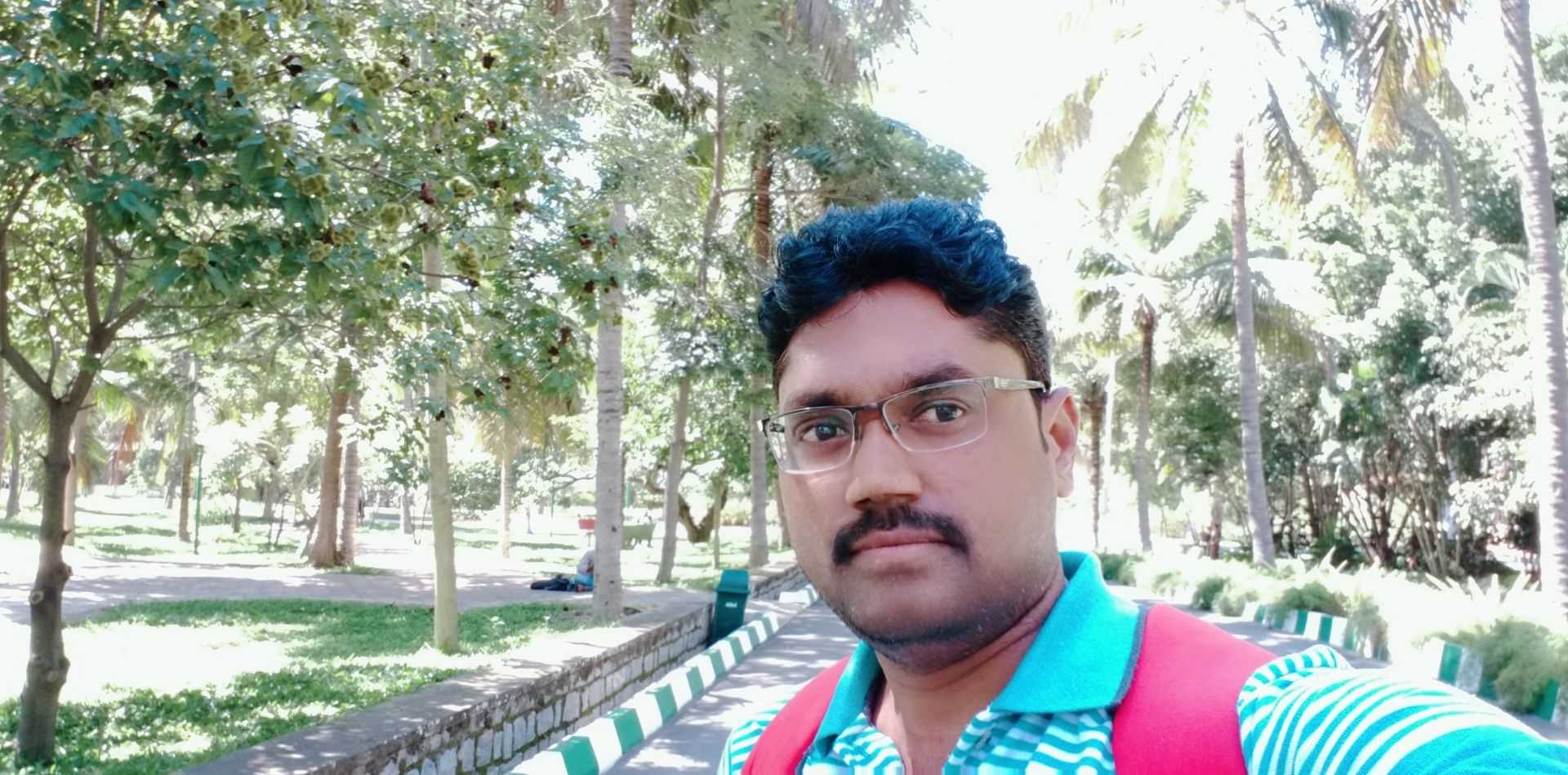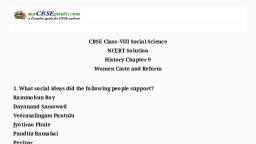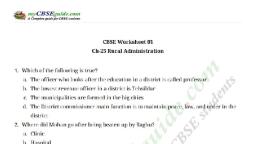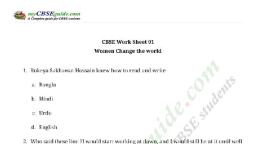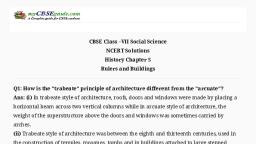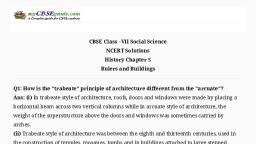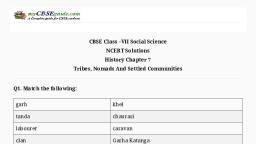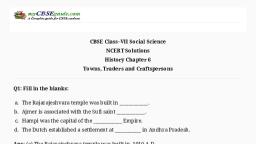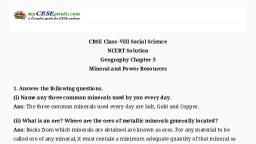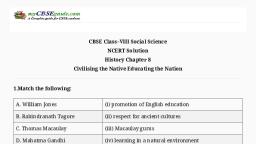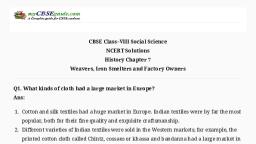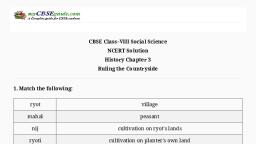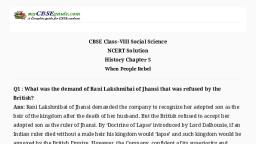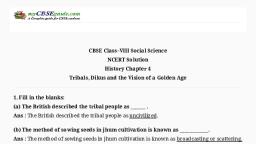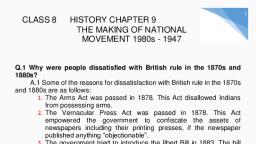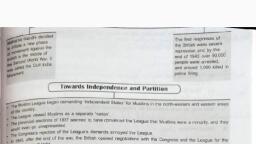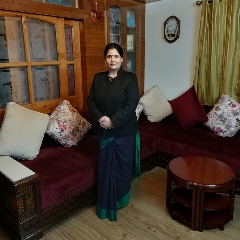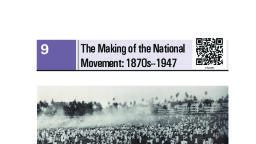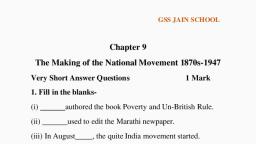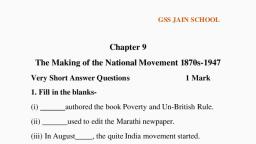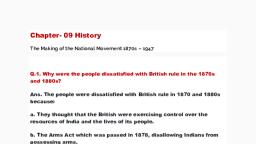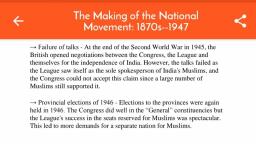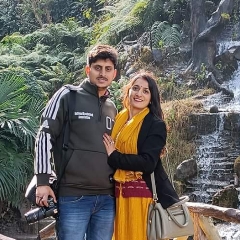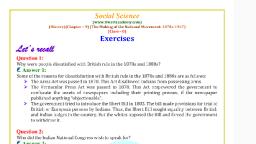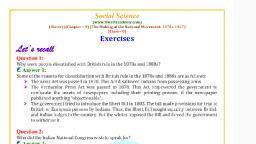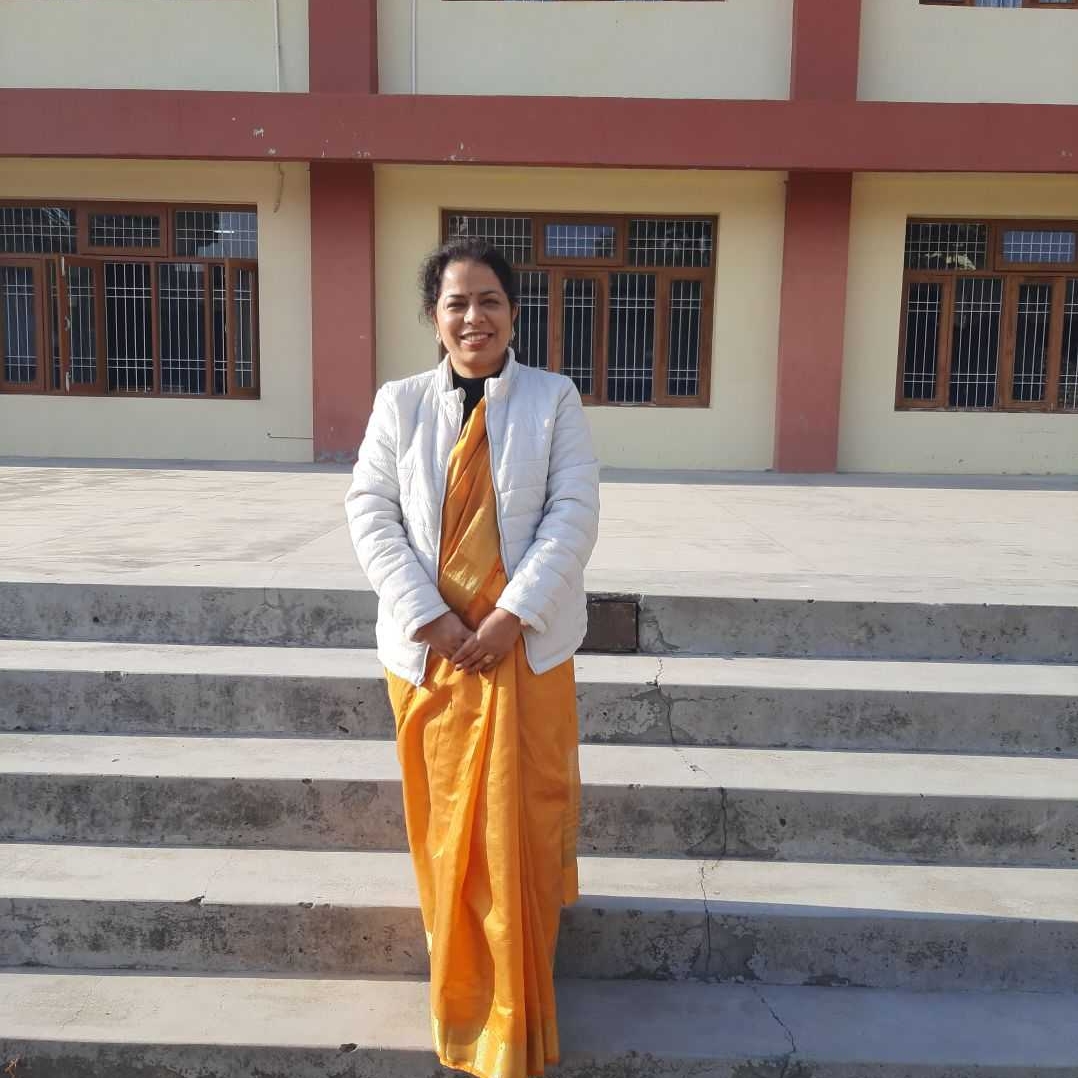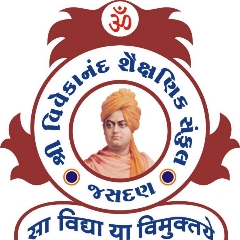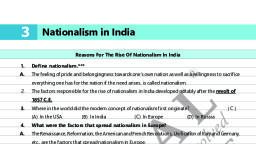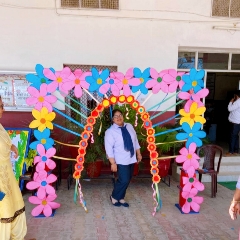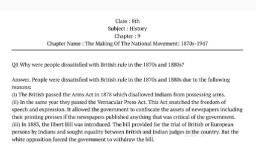Page 1 :
CBSE Class–VIII Social Science, NCERT Solution, History Chapter 11, The Making of the National Movement 1870s–1947, , 1. Why were people dissatisfied with British rule in the 1870s and 1880s?, Ans : National political consciousness began to emerge in the country as people were, dissatisfied with British rule in the 1870s and 1880s due to the following reasons:, i. The Arms Act- This Act was passed in 1878 disallowing Indians from possessing arms, without a valid license., ii. Vernacular Press Act was passed in 1878 .This Act was aimed at silencing those who, were critical of the government. Under this Act, the government could confiscate the, assets of newspapers if they published anything that was found “objectionable”., iii. The Ilbert Bill controversy- The Ilbert bill was passed in 1883 by Lord Ripon. This bill, provided for the trial of British or European individuals by Indians, and sought equality, between British and Indian judges in the country. However, the white opposition forced, the government to withdraw the bill. This enraged the Indians further., iv. Peasants exploitation - Exploitation of Indian peasants continued unabated. There was, no relief from famines., v. Indian representation in the Governor General's council was only nominal and was, limited to the Zamindar class who were staunch British supporters., , 2. Who did the Indian National Congress wish to speak for?, Ans : Indian National Congress wished to speak for all the people of India, irrespective of, class, colour, caste, creed, language or gender. It stated that India, its resources and systems, were not of any specific class or community but of all the citizens of India.Thus, it wished to, speak for all the people of the country., , 3. What economic impact did the First World War have on India?, Ans : The following are the economic impacts of First World War on India:, (i) Negative Effects:, , Material downloaded from myCBSEguide.com., , 1/5
Page 2 :
1. There was huge rise in expenditure of defence of Government of India., 2. Increased taxes on income of individual and business profits by the Government., 3. There has been sharp increase in prices due to increase in expenditure., 4. All this created difficulties for common people., 5. Agriculture was adversely effected for two reasons:, India lost a million soldiers who were farmer's children., Supply was concentrated to war fronts which reduced farmer's reserve., (ii) Profits:, 1. Due to increase in demands of industrial good such as jute bags, cloth, rails,etc business, groups reaped fabulous profits., 2. Expansion of Indian industries due to decline in imports by other countries in India., , 4. What did the Muslim League resolution of 1940 ask for?, Ans: The Muslim League resolution of 1940 asked for "Independent States" for Muslims in, the Eastern and North-Western areas of the country. Chaudhary Rehmat Ali had coined the, term 'Pakistan' in 1932., , 5. Who were the Moderates? How did they propose to struggle against British rule?, Ans: The leaders of Congress in the first twenty years were termed as moderate., i. The Moderate leaders developed public awareness about the unjust nature of British, rule. They published newspapers, wrote articles and showed how British rule was, leading to the economic ruin of the country., ii. They criticised British rule in their speeches and sent representatives to different parts of, the country to mobilise public opinion., iii. They believed that the British had respect for the ideals of freedom and justice and, therefore they would definitely accept just all the demands of the people of India. Their, main task was to acknowledge the British government with these demands., , 6. How was the politics of the Radicals within the Congress different from that of the, Moderates?, , Material downloaded from myCBSEguide.com., , 2/5
Page 3 :
Ans :, 1. The Radicals were opposed to the “politics of prayers” followed by the Moderates within, the Congress., 2. They explored more radical objectives and methods. They emphasised the importance of, self reliance and constructive work., 3. They argued that people must rely on their own strength, not on the “good” intentions of, the government (as was the stated policy of the Moderates)., 4. They believed that people must fight for swaraj., , 7. Discuss the various forms that the Non-Cooperation Movement took in different, parts of India. How did the people understand Gandhiji?, Ans: The Non-Cooperation Movement gained momentum during 1921 and 1922., i. Thousands of students left government-controlled schools and colleges, ii. Many lawyers gave up their practices, iii. British titles were surrendered, iv. Legislatures were boycotted, v. People lit public bonfires of foreign cloth., In most cases, the calls for non-cooperation were related to local grievances., i. In Kheda, Gujrat, Patidar peasants organised non-violent campaigns against the high land, revenue demand of the British., ii. In coastal Andhra and interior Tamil Nadu, liquor shops were picketed., iii. In the Guntur district of Andhra Pradesh, tribals and poor peasants protested against the, colonial state for restricting their use of forest resources. They staged a number of “forest, satyagrahas”, sometimes sending their cattle into forests without paying grazing fees., iv. In Punjab, the Akali agitation of the Sikhs sought to remove corrupt mahants - supported, by the British - from their gurudwaras., v. In Assam, tea garden labourers demanded a big increase in their wages. When the, demands were not met, they left the British-owned plantations., People interpreted Gandhiji according to their own circumstances:, 1. People thought Gandhiji as messiah, someone who could help them overcome their, Material downloaded from myCBSEguide.com., , 3/5
Page 4 :
misery and poverty., 2. Peasants believed that he would help them in their fight against zamindars, while, agricultural labourers felt that he would provide them with land., , 8. Why did Gandhiji choose to break the salt law?, Ans :, 1. Gandhiji chose to break the salt law as British government had a monopoly on the, manufacture and sale of salt. It also imposed a tax on the sale of salt., 2. Gandhiji believed that it was sinful to tax salt as it was an essential part of food., 3. He led a march to the coastal town of Dandi, where he broke the salt law by gathering, natural salt found on the seashore, and boiling sea water to produce salt., 4. This march related the general desire of freedom to a specific grievance shared by, everybody, and thus, did not divide the rich and the poor., , 9. Discuss those developments of the 1937-47 period that led to the creation of Pakistan., Ans : The developments of the 1937-47 that lead to the creation of Pakistan are as follows:, i. A two-nation theory: The Muslim League began viewing the Muslims as a separate, “nation” from the Hindus from the late 1930s., ii. 1937's Provincial elections: 1937's provincial elections convinced the League that, Muslims were a minority, and they would always have to play second fiddle in any, democratic structure. It feared that Muslims may even go unrepresented., iii. Rift between Congress and Muslim League: The proposal of Muslim league was, rejected by Congress.for a joint Congress-League government in the United Provinces in, 1937. This annoyed the League., iv. Wide mass support base for Muslim League: The Congress failed to mobilise the, Muslim masses in the 1930's.This allowed the Muslim League to widen its social support., It sought to enlarge its support in the early 1940s when most Congress leaders were in, jail., v. Failure of talks: At the end of the Second World War in 1945, the British opened, negotiations between the Congress, the League and themselves for the independence of, India. However, the talks failed as the League saw itself as the sole spokesperson of, India's Muslims, and the Congress could not accept this claim since a large number of, Material downloaded from myCBSEguide.com., , 4/5
Page 5 :
Muslims still supported it., vi. Provincial elections of 1946: In 1946, elections to the provinces were again held. The, Congress did well in the “General” constituencies but the League's success in the seats, reserved for Muslims was spectacular. This led to more demands for a separate nation, for Muslims., vii. Failure of talks again: The British cabinet sent a three-member mission to Delhi to, examine this demand and to suggest a suitable political framework for a free India in, March 1946. This mission suggested that India should remain united and constitute itself, as a loose confederation with some autonomy for Muslim-majority areas. But it could not, get the Congress and the Muslim League to agree to specific details of the proposal., Partition was now more or less inevitable., viii. Mass agitation and riots: The Muslim League decided on mass agitation for winning its, Pakistan demand after the failure of the Cabinet Mission.16th August 1946 was, proclaimed as “Direct Action Day”. Riots broke out in Calcutta on this day that lasted, for several days and resulting in the death of thousands of people. Violence had spread to, different parts of Northern India by March 1947., ix. Partition: Finally, the demand for the Partition of India was finalised, and “Pakistan” was, born., , Material downloaded from myCBSEguide.com., , 5/5
